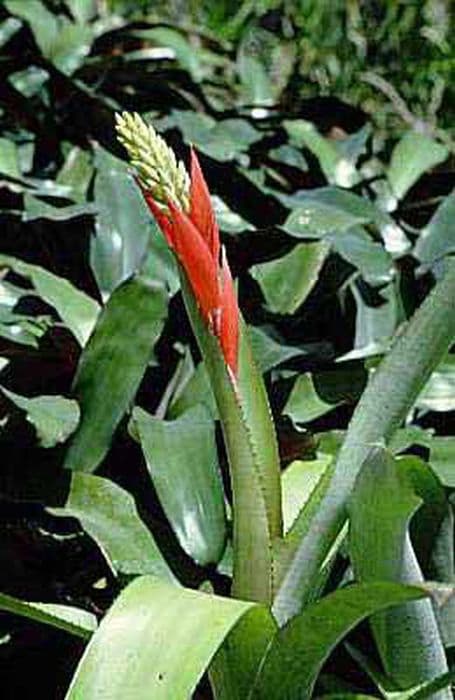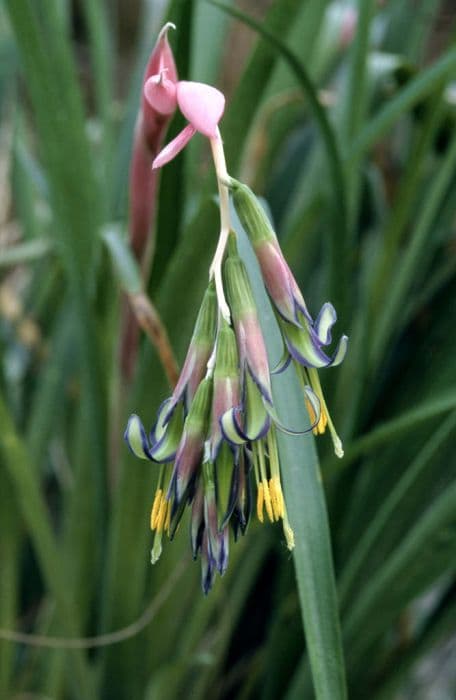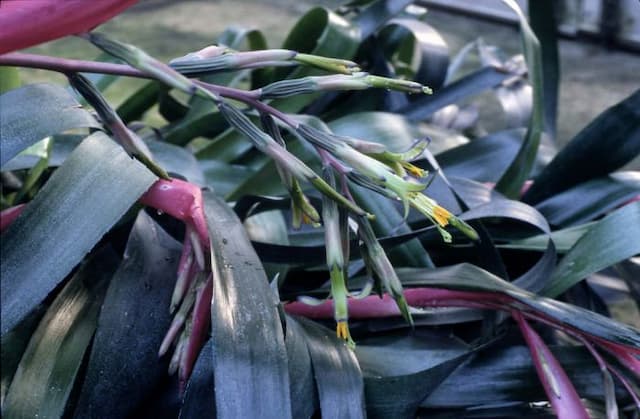Blushing Bride Tillandsia capitata

ABOUT
The Tillandsia capitata, commonly known as the Tillandsia, is characterized by its striking rosette of leaves and unique growth habits. The leaves are broad at the base, tapering to a point, resembling a sword shape, and can vary in color from green to a peach hue as they mature or when exposed to strong light. These hues become more pronounced during the flowering phase. The surface of the leaves typically display a slightly fuzzy texture, due to tiny hairs which help the plant absorb water and nutrients from the air. When it comes to the plant’s reproductive features, the Tillandsia produces a tall inflorescence from its center, sporting exotic and colorful flowers that stand out against the foliage. The flowers can range in color, often showcasing shades of purple, red or yellow, and attract various pollinators. This species is epiphytic, meaning it grows without soil, often attaching itself to other plants or objects. Its roots are used primarily for anchorage rather than nutrient absorption, hence the importance of the leaf structure in its survival. It thrives in environments with good air flow and some humidity, relying on these conditions to meet its moisture requirements. The Tillandsia's overall appearance is both graceful and architecturally interesting, making it a popular choice for display in homes and gardens.
About this plant
 Names
NamesSynonyms
Octopus Plant, Yellow Helmet Air Plant.
Common names
Tillandsia capitata var. buseri, Tillandsia yunckeri
 Toxicity
ToxicityTo humans
Tillandsia capitata, commonly known as the octopus plant, is not considered toxic to humans. There are no well-documented symptoms of poisoning from ingesting the octopus plant as it is generally safe to handle and have in households.
To pets
To the best of my knowledge, the octopus plant is non-toxic to pets as well. It doesn't contain substances known to cause serious harm if ingested by animals. Therefore, pets that ingest this plant typically do not exhibit symptoms of poisoning and it is considered safe to have in homes with pets.
 Characteristics
CharacteristicsLife cycle
Perennials
Foliage type
Evergreen
Color of leaves
Varies
Flower color
Pink
Height
8 inches (20 cm)
Spread
8 inches (20 cm)
Plant type
Herb
Hardiness zones
10
Native area
Mexico
Benefits
 General Benefits
General Benefits- Low Maintenance: Tillandsia capitata does not require soil to grow, making it relatively easy to care for.
- Decorative: With its unique shape and striking color, it adds an aesthetic appeal to any space.
- Drought-Tolerant: As an epiphyte, it's adapted to survive with less water, which is great for water conservation.
- Flexible Placement: It can be placed in a variety of locations, such as mounted on boards, in glass orbs, or simply placed on a shelf.
- Adaptability: It is capable of adapting to a variety of light conditions, making it versatile for different indoor environments.
- Increase Humidity: Through transpiration, it can help increase the humidity levels in a room.
- Education: It serves as an educational tool about unique plant types and ecosystems, particularly epiphytic plants.
- Natural Art: Its natural growth patterns and blooming can be appreciated as a form of living art.
- Fragrant Blooms: When in bloom, it produces fragrant flowers that can contribute to a pleasant olfactory environment.
 Medical Properties
Medical PropertiesThis plant is not used for medical purposes.
 Air-purifying Qualities
Air-purifying QualitiesThis plant is not specifically known for air purifying qualities.
 Other Uses
Other Uses- Tillandsia capitata can be used as a natural adornment for jewelry, such as in living necklaces or earrings, because of their small size and minimal root system.
- The plant serves as a unique decoration for greeting cards or invitations by attaching a small Tillandsia capitata with a bit of adhesive or wire.
- They are popular as biodegradable party favors or eco-friendly gifts due to their ability to live without soil and their minimal care requirements.
- Tillandsia capitata can be incorporated into wearable art pieces like headpieces or corsages for special events like weddings or proms.
- They are used in crafting miniature fantasy gardens or fairy gardens, where they provide an exotic look without the need for frequent watering or soil.
- As a natural sponge in the kitchen, Tillandsia capitata can help cover and keep fruits and vegetables moist because it can retain water in its leaves.
- The plant can act as a living barometer, as certain changes in their leaves can indicate shifts in humidity, helping to predict the weather in a rudimentary fashion.
- They can serve as a biological art medium, with artists using their unique shapes to create living sculptures that evolve over time.
- Tillandsia capitata is sometimes used in educational settings as a tool to teach about botany and the life cycle of plants, as they visibly flower and produce pups.
- In aquariums, although not submerged, these plants can be attached near the surface to create a floating island appearance for aesthetic enhancement.
Interesting Facts
 Feng Shui
Feng ShuiThe Tillandsia capitata, also known as an air plant, can be used in Feng Shui to bring a sense of airiness and to facilitate the flow of chi, especially in areas of the home related to personal growth and spirituality, such as the family or health sector. Displaying an air plant can symbolize freedom and creativity but ensure it is well-maintained and healthy to promote positive energy.
 Zodiac Sign Compitability
Zodiac Sign CompitabilityThe Tillandsia capitata is not used in astrology practice.
 Plant Symbolism
Plant Symbolism- Air and Freedom: As a type of air plant, Tillandsia capitata symbolizes freedom and the ability to thrive outside the conventional bounds of soil-based plants.
- Independence and Self-reliance: This plant draws nutrients and water from the air, signifying autonomy and the capability to take care of oneself.
- Resilience and Adaptability: Tillandsia capitata can adapt to a variety of environments, illustrating resilience and the capacity to endure challenging conditions.
- Uniqueness and Creativity: Their distinct growth habits and striking appearance stand for uniqueness and inspire creative decoration ideas.
 Water
WaterTillandsia capitata, commonly known as the octopus plant, should be watered by soaking it in water for about 20-30 minutes once a week. During hotter, drier periods, soaking twice a week may be necessary. Make sure to shake off any excess water after soaking to prevent rot. If you're using a spray bottle, thoroughly mist the plant until it is completely wet, and do this three to four times a week. It's important not to use distilled water; instead, use filtered, tap, or rainwater. Between waterings, the plant should be allowed to dry out completely.
 Light
LightOctopus plant prefers bright, indirect sunlight. It thrives best when placed near an east or south-facing window where it can receive plenty of light without being scorched by the direct sun. Artificial grow lights can also be used to supplement natural light, especially in darker environments. Ensure the plant is never left under intense midday sunlight as this can damage the leaves.
 Temperature
TemperatureThe octopus plant does best in temperatures between 50 and 90 degrees Fahrenheit. It can survive minimum temperatures down to just above freezing, but growth will be stunted. The ideal range to maintain is between 60 and 80 degrees Fahrenheit, as extreme heat or cold can harm the plant.
 Pruning
PruningPruning is rarely required for the octopus plant. Remove dead or brown leaves to improve the plant's appearance and overall health. The best time to prune is during the growing season, in the spring or early summer. It's also the opportune time to remove any pups or offsets that have formed at the base of the plant if you wish to propagate new plants.
 Cleaning
CleaningAs needed
 Soil
SoilSince the common name for Tillandsia capitata is Air Plant, it does not require soil. Instead, it grows attached to trees or rocks and absorbs moisture from the air. It thrives in an acidic pH range of 5.5-6.0.
 Repotting
RepottingAir Plants like Tillandsia capitata do not need repotting as they do not grow in soil. They are epiphytes and prefer to be mounted or placed in a bright, airy location.
 Humidity & Misting
Humidity & MistingAir Plants such as Tillandsia capitata thrive in high humidity conditions, ideally between 50% and 70%. They benefit from frequent misting to maintain adequate moisture levels.
 Suitable locations
Suitable locationsIndoor
Mount on wood or place in bright, indirect light.
Outdoor
Hang or mount in shaded areas, avoid direct sunlight.
Hardiness zone
9-11 USDA
 Life cycle
Life cycleTillandsia capitata, commonly known as the Capitata Air Plant, begins its life cycle when seeds disperse from the parent plant, usually through wind or water. These seeds land on a suitable substrate, often another plant or structure, and germinate into small shoots. As the shoots develop, they absorb moisture and nutrients from the air, through their specialized leaves, a process called CAM photosynthesis. The plant goes through a phase of vegetative growth, maturing and growing larger with rosette-forming leaves. After reaching maturity, which can take several years, Tillandsia capitata produces a flower spike with vibrant, showy bracts from which flowers emerge for pollination. Following flowering, the plant will eventually produce seeds and then die, completing its life cycle, but often only after it has produced offsets, or "pups," at its base that will grow into new plants.
 Propogation
PropogationPropogation time
Spring to Summer
The most popular method of propagating Tillandsia capitata, commonly known as the octopus plant, is through the separation of offsets, also known as "pups." This usually occurs after the parent plant has flowered. As the pups form at the base of the plant and reach about one-third of the size of the parent, they can be gently twisted or cut off using a sharp, sterilized blade. These pups should then be allowed to dry for a few hours to let the cut surface callous over before being placed in a bright area with good air circulation to root. Watering is done by misting thoroughly, and they should never be left sitting in water. With proper care, these pups will grow into mature Tillandsia capitata plants, ready to flower in time.









